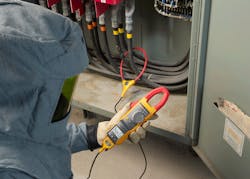If you plan on working on photovoltaic (PV) systems, you’ll need to understand the most common problems you’ll encounter, how to troubleshoot the system, and how to make repairs to get the system back up and running. Before you start your evaluation, gather as much information about the problem as possible, such as:
• When did the problem occur?
• When was the last known time the PV system operated normally?
In addition, obtain the system prints, outputs, and wiring diagrams.
Problem No. 1: Troubleshooting the Cell, Module, and Array
Start your evaluation by checking the output of the entire system at the point of metering or at the inverter. Prior to getting on the roof, check and record the inverter’s input voltage and current level from the array. If the entire PV system is down and not producing power, it may be an inverter problem. If the PV system is operating at a reduced power output, then the problem may be located at one of the arrays or modules. You will have to trace out the individual branch wiring backward from the concentrator.
When you get up on the roof, visually check the entire system for any obvious damage. In addition, keep in mind that the wiring may have been accidentally disconnected during service of another device on the roof.
Once you have identified the module or array that is not producing power, check all wiring, switches, fuses, and circuit breakers. Replace blown fuses and reset the tripped breakers. Since the PV system is on the roof, a lightning strike or power surge may have affected it. With the large amount of wiring present, check for broken wires and loose or dirty connections. Replace and clean as needed. Be on the lookout for twist-on wire type connectors that might have been used to connect modules — they may have worked loose and be causing a lack of contact.
Troubleshoot the system concentrators where individual wires from the modules are sitting behind. Each module may have a fuse that should be checked with a clamp meter.
Wiring problems and loose connections can prohibit one or many modules from producing enough voltage. After checking all wiring connections, you’ll know that any module with low output has an individual section of bad cells. Using the clamp meter and starting at the junction box, trace these back until a culprit is found.
Dirty or shaded modules can also cause a reduced output. Although the modules are typically designed to be maintenance-free for years, they may need to be cleaned. Pollen buildup can be a problem in some areas of the country. Check the system with the clamp meter after any corrections are made.
Problem No. 2: Troubleshooting System Loads
First, check the load switches, fuses, and circuit breakers with the clamp’s voltmeter to see that the proper voltage is present at the load’s connection point. Next, use the clamp meter to check the fuses and circuit breakers. If there are blown fuses or tripped breakers, locate the cause and fix or replace the faulty component. If the load is a motor, an internal thermal breaker might be tripped or there might be an open winding in the motor. For testing purposes, plug in another load and see if it operates properly.
As with any electrical system, check for broken wires and loose connections. Clean all dirty connections and replace all bad wiring. With the power off, check for and repair any ground faults. If any fuses and breakers blow or trip again, then there’s a short that must be located and repaired.
If the load still does not operate properly, use the clamp meter to check the system’s voltage at the load’s connection point. The wire size may be too small and need to be increased. It may also be possible that the wires running to the load are too long, which will show up as low voltage at the load. In this case, you can reduce the load on the circuit or run a larger wire.
Problem No. 3: Troubleshooting Inverters
The inverter in a PV system converts DC power to AC power for building use and can be a point of failure. If the inverter is not producing the correct output, first use the clamp’s voltmeter and DC ammeter to check and record the inverter’s operating DC input voltage and current level. On the AC side, use the clamp meter to check the inverter’s output voltage and current levels.
Many of these systems have a display that indicates current inverter and system performance. A clamp meter that produces a true-rms reading will allow you to use the voltage and current to measure and record the kilowatt (kW) output. If possible, use the clamp meter’s inverter display to show the current total kilowatt hours (kWh). You can then write down this value and compare it to the one recorded during the last inspection.
If the inverter is not producing the expected amount of power, there may be several problems — all of which can be easily checked with a reliable clamp meter — including a blown fuse, tripped breaker, and broken wires. You should also measure the AC side of the inverter because the load on the inverter may have a current demand that is too high. At this point, you can either reduce the loads or install a larger converter. With the power turned off, check for and repair any ground faults before restarting the inverter.
The inverter may be tied into the local electric utility. The AC current output from the inverter will fluctuate with the level of solar input on the array. The inverter maintains the correct output voltage and phase to the electric utility. Any voltage problems from the electric utility may cause the inverter to shut down. In this event, contact the electric utility for repairs.
Silvey is an application specialist with Fluke Corp., Everett, Wash. He can be reached at [email protected].
About the Author

Sean Silvey
Application Specialist
Sean Silvey is an application specialist for Fluke, which manufactures electrical test and measurement tools, including multimeters, clamp meters and insulation, earth ground and installation testers. Sean Silvey has been an application specialist at Fluke for the past seven years. Prior to that, he was a residential/commercial HVAC technician, most recently a field service manager. Sean’s focus is on application awareness and product education; and most recently, he has been building expert knowledge in the Clean Tech fields of solar and eMobility, helping Fluke drive innovation of tools that help technicians in these fields get their work done safely and efficiently.


